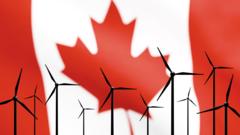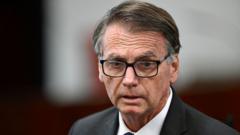With the federal election approaching, Canada’s leading candidates are steering away from climate policy discussions and refocusing on energy infrastructure, anticipating an increasing reliance on fossil fuels.
Canada's Election Pivots on Energy as Climate Issue Fades

Canada's Election Pivots on Energy as Climate Issue Fades
In a surprising shift, Canadian election candidates spotlight fossil fuels while climate concerns dwindle from discourse.
As the Canadian federal election approaches, the once-dominant discourse surrounding climate change is receding, overtaken by a renewed emphasis on energy independence and economic concerns exacerbated by geopolitical tensions. The two principal contenders, Mark Carney of the Liberal Party and Pierre Poilievre of the Conservative Party, are advocating for considerably divergent approaches toward energy policy, reminiscent of the pressing issues surrounding fossil fuel production.
Mark Carney, the current Prime Minister, seeks to position Canada as a global leader in both clean and fossil fuels. He comes from a legacy of environmental advocacy, previously serving as a prominent figure in climate action on the international stage. Yet, his recent decision to repeal the consumer carbon levy—implemented in 2019 to penalize fossil fuel use—has sparked debates on the efficacy of his climate commitment. Critics argue that by removing such regulations early on, Carney underscored the notion that climate initiatives detrimentally impact economic viability.
In contrast, Pierre Poilievre aims to bolster Canada's oil and gas sector while abolishing the industrial carbon tax altogether, reflecting a significant pivot from the shared consensus on ecological action that characterized the previous election. With Canada's acute dependence on the U.S. for its energy market and the ongoing disruptions stemming from international conflicts, both candidates are working to reassess the nation’s energy strategy to reduce reliance on American energy markets—a shift presumed vital by both parties, given the changing geopolitical landscape.
Public opinion appears increasingly swayed by immediate economic concerns, particularly regarding inflation and rising living costs. The war in Ukraine has further magnified discussions surrounding Canada’s substantial natural resource portfolio, leading many to prioritize energy production to stabilize the economy, rather than environmental considerations.
Despite this refocusing on fossil fuels, Karney's rhetoric concerning renewable energy—although vague—proposes investments in sustainable projects, potentially aiming to forge a middle ground for the Liberals amid environmental pressures. Nonetheless, with climate scientists warning that Canada is significantly lagging in its carbon reduction commitments, skepticism looms over whether these energy policies can reconcile with the nation’s environmental obligations.
As voters prepare to head to the polls in late April 2025, a looming challenge remains for both candidates—to navigate a path that addresses both the pressing economic concerns of their constituents and the imminent climate crisis that continues to shift public attention unpredictably. The trajectory chosen by the next Prime Minister could have enduring implications for Canada’s environmental future.
Mark Carney, the current Prime Minister, seeks to position Canada as a global leader in both clean and fossil fuels. He comes from a legacy of environmental advocacy, previously serving as a prominent figure in climate action on the international stage. Yet, his recent decision to repeal the consumer carbon levy—implemented in 2019 to penalize fossil fuel use—has sparked debates on the efficacy of his climate commitment. Critics argue that by removing such regulations early on, Carney underscored the notion that climate initiatives detrimentally impact economic viability.
In contrast, Pierre Poilievre aims to bolster Canada's oil and gas sector while abolishing the industrial carbon tax altogether, reflecting a significant pivot from the shared consensus on ecological action that characterized the previous election. With Canada's acute dependence on the U.S. for its energy market and the ongoing disruptions stemming from international conflicts, both candidates are working to reassess the nation’s energy strategy to reduce reliance on American energy markets—a shift presumed vital by both parties, given the changing geopolitical landscape.
Public opinion appears increasingly swayed by immediate economic concerns, particularly regarding inflation and rising living costs. The war in Ukraine has further magnified discussions surrounding Canada’s substantial natural resource portfolio, leading many to prioritize energy production to stabilize the economy, rather than environmental considerations.
Despite this refocusing on fossil fuels, Karney's rhetoric concerning renewable energy—although vague—proposes investments in sustainable projects, potentially aiming to forge a middle ground for the Liberals amid environmental pressures. Nonetheless, with climate scientists warning that Canada is significantly lagging in its carbon reduction commitments, skepticism looms over whether these energy policies can reconcile with the nation’s environmental obligations.
As voters prepare to head to the polls in late April 2025, a looming challenge remains for both candidates—to navigate a path that addresses both the pressing economic concerns of their constituents and the imminent climate crisis that continues to shift public attention unpredictably. The trajectory chosen by the next Prime Minister could have enduring implications for Canada’s environmental future.






















